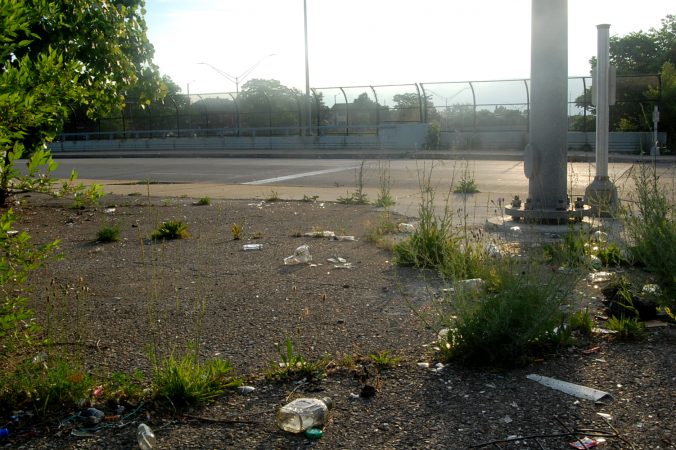40 liquor bottles, 33 fast-food containers, six cans, 13 plastic bags, 31 plastic bottles, a broken hookah pipe, a comb, and countless vape pens, nitrous chargers, PPE, cigarettes, and lotto tickets. What does all of this have in common? It’s all sitting on the corner of the westbound I-96 exit to Joy Road, just before the light, waiting, for nothing.
The results of the examination of discarded personal trash scattered around one corner of one highway exit on one day in mid-June may seem like a hyperbolic exaggeration or an example that’s been cherry-picked for emphasis, but they are no exception to the standard. This city is complicated. Many people from different walks of life, living within its borders for different reasons, and utilizing different parts of the city for their own reasons. But no matter who you are or what you’re doing, if you live in Detroit, you won’t be surprised to learn that there’s a problem with trash, and it’s time to talk about it.

80% OF TRASH ON THE GREAT LAKES SHORELINE IS PLASTIC. PHOTO NICK FEWINGS / UNSPLASH
Although the word “litter” adequately defines the debris we see daily, it provokes a narrow comprehension of the issue’s source, especially in Detroit. The term’s deployment typically evokes imagery of a careless individual throwing a used wrapper, container, or piece of trash on the ground in a public space.
However, the problem of poor personal waste management can also be traced to all kinds of habits that have been normalized like illegal dumping, inadequately servicing trash bins, neglecting worksite cleanup, and poor event clean-up coordination. This means that the trash problem needs to be faced with an open mind and a big picture perspective so that little slips through the cracks.
As disturbing as it is to see a wave of abandoned fast-food packaging tumbling through Grand River’s traffic on a windy day, the aesthetic is the least concerning of the issues caused by litter.
Waste mismanagement is a disorganized and inconsistent problem making it hard to quantify. It’s hard to see exactly how Detroit compares to other cities and determining the severity of our contribution to global waste mismanagement is rife with speculation.
According to the Detroit Department of Public Works, in 2018, 92 million pounds of litter were collected from illegal dumping sites. Detroit’s proximity to a major waterway is a game-changer. Trash can lower the oxygen levels in water systems, change the ph balance, and create immediate hazards for wildlife.
One of the most commonly littered items is cigarette butts. They are filled with chemicals that, if concentrated, devastate the environment. One study by Clean Virginia Waterways determined that there is significant toxicity from arsenic in cigarette filters which has the ability to damage ecosystems and harm wildlife.
Plastic, a common litter item, according to the EPA, has the greatest potential for harm, serving as a transport for dangerous chemicals and contaminants directly into the food chain. According to the United Nations Environment Programme, 100,000 marine mammals are killed by plastic every year. Let’s not forget, we humans eat marine life.
The Rochester Institute of Technology estimated that 22 million pounds of plastic find their way into the Great Lakes

ACCORDING TO THE EPA, MARINE LITTER OFTEN COMES FROM POORLY MANAGED TRASH ON LAND. PHOTO KAHARI KING / UNSPLASH
annually. Each year, Lake Erie, which the Detroit River feeds, receives 4.41 metric tons of surface water microplastics. Although there is limited data on the topic, there is scientific concern that ingesting microplastics is harmful to humans. Litter also creates hazards in human transportation, it can incubate disease and interferes with economic progress.
So what do we do about it? The enormity of our waste and its consequences can feel overwhelming and consternation is amplified when one is reminded of the multitude of origins from which the problem germinates. There is not just one source, one easily identifiable perpetrator to apprehend, not one poor contributing habit to curb, or one implementable preventative measure to fix it.
Natalie Jakub is the Executive Director for Green Living Science, a nonprofit outgrowth of Recycle Here! She is also Chair of the Recycling and Waste Reduction Committee for Detroit City Council’s Green Taskforce. Jakub says the best way to start is with the low-hanging fruit, giving the example of the GLS response to the realization that a lot of mismanaged trash comes from events hosted in Detroit by companies from out of town.
The Green Task Force created a guidebook that provides comprehensive information on how to reduce waste when hosting an event.
We’re not necessarily saying you should recycle cause we know that’s not always a solution but here’s a simple way to reduce your waste. Also when you reduce waste you save money.
As a member of GTF Jakub is responsible for creating policy recommendations for the City Council which has shown recent activity. In 2020 DCC adopted a resolution to support event waste reduction. Another resolution supports accountability through supervision and oversight regarding demolition projects in Detroit which have a history of poor waste management practices.
There have been some recent changes to the Handling of Solid Waste and Prevention of Illegal Dumping Ordinance and the city launched a commercial recycling program in the last month, but little else has been done to amend city policy. Jakup says this is partly because The State has been working to amend the waste management section of the Natural Resources and Environmental Protection Act for a couple of years “which will influence what counties or cities are able to do, or what they should be doing as it relates to sustainable materials management.”
She says policymakers in Detroit have been waiting on those amendments before making real changes to city ordinances. Still, the GTF is looking to implement a deconstruction program that could limit the need for new building materials and reduce landfill costs.
Some citizens motivated to make a change have turned to community activism. Mark Walsh has lived in Detroit for four years. He started a community cleanup group called Detroit vs Litter as a way to combat the neighborhood trash he sees every day. “The area down the street from my house was being used as an unofficial dump and (…) you could spend all day picking up the street but the trash blows all around from other areas.” Because of this, he says the best place to start is the worst area with the most dumping. Walsh intends to scale up this summer, encouraging more attendance and hosting events once a week in neighborhoods across the city.
Specific ways to address particular contributors like this are important but it’s also important to shift the way we perceive the issue. A common reflex in this conversation is to criticize the government for not enforcing the law. One may argue that the undesirable behavior can be most quickly revised by creating an immediate negative consequence and this would lead to a change in the social norm.
The correlation between punishment for littering and clean public spaces could understandably be reinforced by looking to surrounding communities that don’t struggle with such a waste management problem. An infraction in a suburb of Detroit, Birmingham, MI, for example, is more likely to be met with a fine and there is a significant difference in observable litter between the two municipalities.
However, the logic fails to recognize the possibility that Detroit’s waste issue may be correlated with its poverty. Detroit is the second poorest big city in the country. 30.6% of its residents live below the poverty line. There are many reasons why poverty may be connected to litter and if it is, then it must be examined as a factor in addressing the issue.
An article published in Waste Management World titled Poverty is No Excuse: The Psychology Behind Litter argues that the correlation rests not between litter and poverty but between litter and social disorder. The article references the broken window theory which suggests that societal decay or physical deterioration reduces an individual’s perceived value of something which then reduces their concern for complying with social norms regarding that thing. In our scenario, the deterioration would be caused by preexisting blight or trash and that thing would be the city itself.
But in Detroit, poverty and societal decay have a long interwoven history. Historians often credit poverty as the underlying reason for the 1967 Riots which are seen as a marker for the beginning of the period during which many residents abandoned the city. According to The Detroit Historical Society, “The uprising was a turning point for the city. White flight in 1967 doubled to over 40,000 and doubled again the next year. Yet, many Detroiters remained.” The white exodus from Detroit is responsible for a lot of the city’s decay.
If it is the case that poverty is a factor in creating poor waste management, then it isn’t sensible to punish citizens financially for an issue caused by financial instability. Jakub says “We don’t want to be ticketing you for throwing a piece of paper on the ground. That’s like a 150 dollar ticket and now you can’t eat that week.”
Jakub says statistics from other communities suggest that positive reinforcement tends to work better anyway, “Some sort of gold star program is helpful. But as it relates to litter that’s a little harder to do because you can’t thank people for not littering or you’d be thanking everybody.” Instead, she’s thinking about developing an ambassador program where individuals are given a sense of leadership and ownership of the community. They would act as eyes and ears for the city and advocate for better waste management in the parks.
Perhaps the greatest change we need to see is cultural. Proper waste management practices aren’t often taught at home, partly because city services have been changing and the information isn’t getting to residents as easily as it should. “A lot of residents don’t know about the services they have. There’s a digital divide, they can’t just google it so we have to make things easily accessible,” says Jakub.
Consistent curbside recycling wasn’t provided until 2014 so many Detroit residents never learned how to or why they should recycle. It just isn’t part of the culture. GLS hopes to change that with regular school assemblies, field trips, and other interactive programs.
Walsh also sees education to be a critical component in addressing the issue. He says he ordered all his neighbor’s recycling bins,
All my neighbors recycle now. I taught them what to recycle and what not to. Focus on the neighborhoods and teach people that littering is bad. I think that is ultimately the most helpful thing.
Regardless of the source of the issue or the ways we will address it, it’s apparent that proper waste management is becoming more of a priority to the citizens of Detroit. The Sustainability Action Agenda, an interdepartmental effort that engaged with the community and researched what residents would value in a sustainable city framework, revealed that the second-highest concern is clean and safe neighborhoods. Jakub says, “The Green Task Force is trying to do what it can to get these conversations started. We may not see them all the way through but we should be talking about this.”























